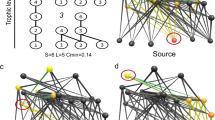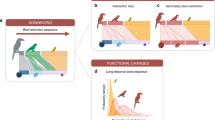Abstract
Intensified exploitation of natural populations and habitats has led to increased mortality rates and decreased abundances of many species1,2. There is a growing concern that this might cause critical abundance thresholds of species to be crossed1,3,4,5, with extinction cascades and state shifts in ecosystems as a consequence4,6,7. When increased mortality rate and decreased abundance of a given species lead to extinction of other species, this species can be characterized as functionally extinct even though it still exists. Although such functional extinctions have been observed in some ecosystems3,4,8, their frequency is largely unknown. Here we use a new modelling approach to explore the frequency and pattern of functional extinctions in ecological networks. Specifically, we analytically derive critical abundance thresholds of species by increasing their mortality rates until an extinction occurs in the network. Applying this approach on natural and theoretical food webs, we show that the species most likely to go extinct first is not the one whose mortality rate is increased but instead another species. Indeed, up to 80% of all first extinctions are of another species, suggesting that a species’ ecological functionality is often lost before its own existence is threatened. Furthermore, we find that large-bodied species at the top of the food chains can only be exposed to small increases in mortality rate and small decreases in abundance before going functionally extinct compared to small-bodied species lower in the food chains. These results illustrate the potential importance of functional extinctions in ecological networks and lend strong support to arguments advocating a more community-oriented approach in conservation biology, with target levels for populations based on ecological functionality rather than on mere persistence8,9,10,11.
This is a preview of subscription content, access via your institution
Access options
Subscribe to this journal
Receive 51 print issues and online access
$199.00 per year
only $3.90 per issue
Buy this article
- Purchase on Springer Link
- Instant access to full article PDF
Prices may be subject to local taxes which are calculated during checkout



Similar content being viewed by others
References
Jackson, J. B. C. et al. Historical overfishing and the recent collapse of coastal ecosystems. Science 293, 629–637 (2001)
Myers, R. A. & Worm, B. Rapid worldwide depletion of predatory fish communities. Nature 423, 280–283 (2003)
Terborgh J., Estes J. A., eds. Trophic Cascades: Predators, Prey, and the Changing Dynamics of Nature (Island Press, 2010)
Estes, J. A. et al. Trophic downgrading of planet earth. Science 333, 301–306 (2011)
Anderson, S. H., Kelly, D., Ladley, J. J., Molloy, S. & Terry, J. Cascading effects of bird functional extinction reduce pollination and plant density. Science 331, 1068–1071 (2011)
Barnosky, A. D. et al. Approaching a state shift in Earth's biosphere. Nature 486, 52–58 (2012)
Scheffer, M., Carpenter, S., Foley, J. A., Folke, C. & Walker, B. Catastrophic shifts in ecosystems. Nature 413, 591–596 (2001)
Estes, J. A., Tinker, M. T. & Bodkin, J. L. Using ecological function to develop recovery criteria for depleted species: sea otters and kelp forests in the aleutian archipelago. Conserv. Biol. 24, 852–860 (2010)
Soulé, M. E., Estes, J. A., Berger, J. & Del Rio, C. M. Ecological effectiveness: conservation goals for interactive species. Conserv. Biol. 17, 1238–1250 (2003)
Soulé, M. E., Estes, J. A., Miller, B. & Honnold, D. L. Strongly interacting species: conservation policy, management, and ethics. Bioscience 55, 168–176 (2005)
Sabo, J. L. Population viability and species interactions: life outside the single-species vacuum. Biol. Conserv. 141, 276–286 (2008)
McConkey, K. R. & Drake, D. R. Flying foxes cease to function as seed dispersers long before they become rare. Ecology 87, 271–276 (2006)
Casini, M. et al. Trophic cascades promote threshold-like shifts in pelagic marine ecosystems. Proc. Natl Acad. Sci. USA 106, 197–202 (2009)
Frank, K. T., Petrie, B., Choi, J. S. & Leggett, W. C. Trophic cascades in a formerly cod-dominated ecosystem. Science 308, 1621–1623 (2005)
Smith, A. D. et al. Impacts of fishing low-trophic level species on marine ecosystems. Science 333, 1147–1150 (2011)
Berg, S., Christianou, M., Jonsson, T. & Ebenman, B. Using sensitivity analysis to identify keystone species and keystone links in size-based food webs. Oikos 120, 510–519 (2011)
Berlow, E. L. et al. Simple prediction of interaction strengths in complex food webs. Proc. Natl Acad. Sci. USA 106, 187–191 (2009)
Stouffer, D. B. & Bascompte, J. Compartmentalization increases food-web persistence. Proc. Natl Acad. Sci. USA 108, 3648–3652 (2011)
IUCN Red List Categories and Criteria:Version 3.1 (2001), http://www.iucnredlist.org/technical-documents/categories-and-criteria/2001-categories-criteria
Paine, R. T. Food web complexity and species diversity. Am. Nat. 100, 65–75 (1966)
Borrvall, C., Ebenman, B. & Tomas Jonsson, T. J. Biodiversity lessens the risk of cascading extinction in model food webs. Ecol. Lett. 3, 131–136 (2000)
Ebenman, B. & Jonsson, T. Using community viability analysis to identify fragile systems and keystone species. Trends Ecol. Evol. 20, 568–575 (2005)
Dunne, J. A., Williams, R. J. & Martinez, N. D. Network structure and biodiversity loss in food webs: robustness increases with connectance. Ecol. Lett. 5, 558–567 (2002)
Colwell, R. K., Dunn, R. R. & Harris, N. C. Coextinction and persistence of dependent species in a changing world. Annu. Rev. Ecol. Evol. Syst. 43, 183–203 (2012)
Lewis, H. M. & Law, R. Effects of dynamics on ecological networks. J. Theor. Biol. 247, 64–76 (2007)
De'ath, G. & Fabricius, K. E. Classification and regression trees: A powerful yet simple technique for ecological data analysis. Ecology 81, 3178–3192 (2000)
Bolker, B. M. et al. Generalized linear mixed models: a practical guide for ecology and evolution. Trends Ecol. Evol. 24, 127–135 (2009)
Chesson, P. & Kuang, J. J. The interaction between predation and competition. Nature 456, 235–238 (2008)
Sahasrabudhe, S. & Motter, A. E. Rescuing ecosystems from extinction cascades through compensatory perturbations. Nat. Commun. 2, 170 (2011)
Ives, A. R. & Cardinale, B. J. Food-web interactions govern the resistance of communities after non-random extinctions. Nature 429, 174–177 (2004)
Bender, E. A., Case, T. J. & Gilpin, M. E. Perturbation experiments in community ecology: theory and practice. Ecology 65, 1–13 (1984)
Montoya, J. M., Woodward, G., Emmerson, M. C. & Sole, R. V. Press perturbations and indirect effects in real food webs. Ecology 90, 2426–2433 (2009)
Acknowledgements
We thank N. Virgo, A. Clark, R. Law, O. Petchey, P. Münger, D. Gilljam, A. Curtsdotter and U. Wennergren for comments and discussion. D. Gilljam and A. Curtsdotter also provided computer code for part of the analysis. This project was supported by a Faculty grant from Linköping University to B.E.
Author information
Authors and Affiliations
Contributions
T.S. and B.E. designed the project, T.S., B.E. and S.S. performed research, T.S. analysed the data, T.S. wrote the Supplementary Information, T.S. and B.E. wrote the manuscript with contributions from S.S.
Corresponding author
Ethics declarations
Competing interests
The authors declare no competing financial interests.
Supplementary information
Supplementary Information
This file contains Supplementary Figures 1-9, Supplementary Methods, Supplementary Tables 1-8 and Supplementary References. (PDF 1862 kb)
Rights and permissions
About this article
Cite this article
Säterberg, T., Sellman, S. & Ebenman, B. High frequency of functional extinctions in ecological networks. Nature 499, 468–470 (2013). https://doi.org/10.1038/nature12277
Received:
Accepted:
Published:
Issue Date:
DOI: https://doi.org/10.1038/nature12277
This article is cited by
-
Reptile responses to outdoor recreation in urban habitat fragments
Urban Ecosystems (2024)
-
Biological, ecological and trophic features of invasive mosquitoes and other hematophagous arthropods: What makes them successful?
Biological Invasions (2024)
-
Reintroduction of at-risk forest tree species using biotechnology depends on regulatory policy, informed by science and with public support
New Forests (2023)
-
Multiple drivers and lineage-specific insect extinctions during the Permo–Triassic
Nature Communications (2022)
-
Impacts of the invasive hornet Vespa velutina on native wasp species: a first effort to understand population-level effects in an invaded area of Europe
Journal of Insect Conservation (2022)
Comments
By submitting a comment you agree to abide by our Terms and Community Guidelines. If you find something abusive or that does not comply with our terms or guidelines please flag it as inappropriate.



